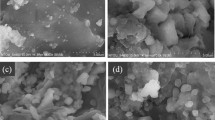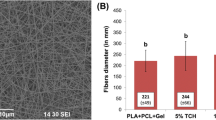Abstract
The objective of this study was to construct lactoferrin (LFA-LFC) chimeric peptide gelatin drug-loaded fiber film by tissue engineering strategy, and study its bacteriostatic effect on oral pathogens (especially Candida albicans) and its effect on biofilm. First of all, LFA-LFC chitosan nanoparticles were prepared firstly, and then fluconazole gelatin (LF/GH/F) film loaded with LFA-LFC was prepared by electrospinning. Scanning electron microscope (SEM), mechanical strength, drug release, cytotoxicity, and real-time PCR were used to test the properties of the synthesized materials. SEM showed that there was the reticular structure for fiber film before and after cross-linking. LF/GH/F film had no obvious cytotoxicity, with good biocompatibility and drug release; real-time PCR and antibacterial test showed that the LF/GH/F film had good antibacterial activity. LF/GH/F film has a good inhibitory effect on oral pathogens, and its mechanism is related to biofilm. The antibacterial experiments of nanofiber membrane in vitro and the effect of bacterial biofilm were carried out. The effect of LF/GH/F on oral microbial flora structure was studied by fluorescence quantitative pest techniques.















Similar content being viewed by others
Data availability
The data used to support the findings of this study are available from the corresponding author upon request.
References
Melkoumov, A., Goupil, M., Louhichi, F., Raymond, M., De Repentigny, L., & Leclair, G. (2013). Nystatin nanosizing enhances in vitro and in vivo antifungal activity against Candida albicans. Journal of Antimicrobial Chemotherapy, 68(9), 2099–2105.
Akpan, A., & Morgan, R. (2002). Oral candidiasis. Postgraduate Medical Journal, 78(922), 455–459.
Epstein, J. B., & Polsky, B. (1998). Oropharyngeal candidiasis: A review of its clinical spectrum and current therapies. Clinical Therapeutics, 20(1), 40–57.
Coronado-Castellote, L., & Jimenez-Soriano, Y. (2013). Clinical and microbiological diagnosis of oral candidiasis. Journal of Clinical and Experimental Dentistry, 5(5), e279–e286.
Samaranayake, L. P., Keung Leung, W., & Jin, L. (2009). Oral mucosal fungal infections. Periodontol., 49, 39–59.
Francesca, B., Ajello, M., Bosso, P., Morea, C., Andrea, P., Giovanni, A., & Piera, V. (2004). Both lactoferrin and iron influence aggregation and biofilm formation in Streptococcus mutans. BioMetals, 17(3), 271–278.
Niu, J. Y., Yin, I. X., Wu, W. K., Li, Q., Mei, M. L., & Chu, C. H. (2020). Antimicrobial peptides for the prevention and treatment of dental caries: A concise review. Archives of Oral Biology, 122, 105022.
Ramakrishna, S., Fujihara, K., Teo, W., et al. (2005). Electrospinning process (pp. 135–137). In An Introduction to Electrospinning and Nanofibers; World Scientific Publishing.
Fu, W., Liu, Z., Feng, B., Hu, R., He, X., Wang, H., et al. (2014). Electrospun gelatin/PCL and collagen/PLCL scaffolds for vascular tissue engineering. International Journal of Nanomedicine, 9, 2335–2344.
Anjum, F., Agabalyan, N. A., Sparks, H. D., Rosin, N. L., Kallos, M. S., & Biernaskie, J. (2017). Biocomposite nanofiber matrices to support ECM remodeling by human dermal progenitors and enhanced wound closure. Science and Reports, 7, 10291.
Lyu, X., Zhao, C., Hua, H., & Yan, Z. (2016). Efficacy of nystatin for the treatment of oral candidiasis: A systematic review and meta-analysis. Drug Design, Development and Therapy, 10, 1161–1171.
Goins, R. A., Ascher, D., Waecker, N., Arnold, J., & Moorefield, E. (2002). Comparison of fluconazole and nystatin oral suspensions for treatment of oral candidiasis in infants. Pediatric Infectious Disease, 21, 1165–1167.
Huang, C., Hu, K., & Wei, Z. (2016). Comparison of cell behavior on pva/pva-gelatin electrospun nanofibers with random and aligned configuration. Science and Reports, 6, 37960.
Lindenberg, M., Kopp, S., & Dressman, J. B. (2004). Classification of orally administered drugs on the World Health Organization model list of essential medicines according to the biopharmaceutics classification system. European Journal of Pharmaceutics and Biopharmaceutics, 58, 265–278.
Loftsson, T., Vogensen, S. B., Desbos, C., & Jansook, P. (2008). Carvedilol: Solubilization and cyclodextrin complexation: A technical note. AAPS Pharm. Sci. Tech., 9, 425–430.
Van Luong, E., Grondahl, L., Chua, K. N., Leong, K. W., Nurcombe, V., & Cool, S. M. (2006). Controlled release of heparin from poly(e-caprolactone) electrospun fibers. Biomaterials, 27, 2042–2050.
Madhaiyan, K., Sridhar, R., Sundarrajan, S., Venugopal, J. R., & Ramakrishna, S. (2013). Vitamin B12 loaded polycaprolactone nanofibers: A novel transdermal route for the water-soluble energy supplement delivery. International Journal of Pharmaceutics, 444, 70–76.
Meinel, A. J., Germershaus, O., Luhmann, T., Merkle, H. P., & Meinel, L. (2012). Electrospun matrices for localized drug delivery: Current technologies and selected biomedical applications. European Journal of Pharmaceutics and Biopharmaceutics, 81, 1–13.
Patel, V. F., Liu, F., & Brown, M. B. (2011). Advances in oral transmucosal drug delivery. Journal of Controlled Release, 153, 106–116.
Pelipenko, J., Kocbek, P., Govedarica, B., Rosic, R., Baumgartner, S., & Kristl, J. (2013). The Topography of electrospun nanofibers and its impact on the growth and mobility of keratinocytes. European Journal of Pharmaceutics and Biopharmaceutics, 84, 401–411.
Behzadi, P., & Behzadi, E. (2011). Modern medical mycology and opportunistic pathogenic yeasts (1st ed.). Persian Science & Research Publisher.
Zumbuehl, A., Ferreira, L., Kuhn, D., et al. (2007). Antifungal hydrogels. Proceedings of the National Academy of Sciences USA 104(32):12994–12998
Ben Khalifa, R., Cacciatore, I., Dimmito, M. P., Ciulla, M., Grande, R., Puca, V., et al. (2022). Multiple lipid nanoparticles as antimicrobial drug delivery systems. Journal of Drug Delivery Science and Technology, 67, 102887.
Takakura, N., Wakabayashi, H., Ishibashi, H., Teraguchi, S., Tamura, Y., Yamaguchi, H., & Abe, S. (2003). Oral lactoferrin treatment of experimental oral candidiasis in mice. Antimicrobial Agents and Chemotherapy, 47(8), 2619–2623.
Pattamatta, U., Willcox, M., Stapleton, F., Cole, N., & Garrett, Q. (2009). Bovine lactoferrin stimulates human corneal epithelial alkali wound healing in vitro. Investigative Ophthalmology & Visual Science, 50, 1636–1643.
Zarif, L., Graybill, J. R., Perlin, D., Najvar, L., Bocanegra, R., & Mannino, R. J. (2000). Antifungal activity of amphotericin B cochleates against Candida albicans infection in a mouse model. Antimicrobial Agents and Chemotherapy, 44(6), 1463–1469.
Gupta, M., Goyal, A. K., Paliwal, S. R., Paliwal, R., Mishra, N., Vaidya, B., et al. (2010). Development and characterization of effective topical liposomal system for localized treatment of cutaneous candidiasis. Journal of Liposome Research, 20(4), 341–350.
Bhalaria, M. K., Naik, S., & Misra, A. N. (2009). Ethosomes: A novel system for antifungal drugs in the treatment of topical fungal disease. Indian Journal of Experimental Biology, 47(5), 368–375.
Ramos, G., Cuenca-Estrella, M., Monzón, A., & Rodríguez-Tudela, J. L. (1999). In-vitro comparative activity of UR-9825, itraconazole and fluconazole against clinical isolates of Candida spp. Journal of Antimicrobial Chemotherapy, 44(2), 283–286.
Prabhu, P., Patravale, V., & Joshi, M. (2012). Nanocarriers for effective topical delivery of anti-infectives. Current Nanoscience, 8(4), 491–503.
Planinšek, O., Kovačič, B., & Vrečer, F. (2011). Carvedilol dissolution improvement by preparation of solid dispersions with porous silica. International Journal of Pharmaceutics, 406, 41–48.
Rosic, R., Kocbek, P., Pelipenko, J., Kristl, J., & Baumgartner, S. (2013). Nanofibers and their biomedical use. Acta Pharmaceutica, 63, 295–304.
Sattar, M., Sayed, O. M., & Lane, M. E. (2014). Oral transmucosal drug delivery– currentstatus and future prospects. Internation Journal of Pharmaceutics, 471, 498–506.
Seif, S., Franzen, L., & Windbergs, M. (2015). Overcoming drug crystallization in electrospun fibers–Elucidating key parameters and developing strategies for drug delivery. International Journal of Pharmaceutics, 478, 390–397.
Pappas, P. G., Kauffman, C. A., Andes, D. R., et al. (2016). Clinical Practice Guideline for the Management of Candidiasis: 2016 Update by the Infectious Diseases Society of America. Clinical Infectious Diseases: An Official Publication of the Infectious Diseases Society of America, 62(4), e1–e50.
Berkow, E. L., & Lockhart, S. R. (2017). Fluconazole resistance in Candida species: A current perspective. Infection and Drug Resistance, 10, 237–245.
Akbar, E., & Syed, N. M. (2017). Synthesis of a novel structure for the oral delivery of insuli n and the study of its effect on diabetic rat. Life Sciences, 186, 43–49.
Vigh, T., Horváthová, T., Balogh, A., Sóti, P. L., Drávavölgyi, G., Nagy, Z. K., & Marosi, G. (2013). Polymer-free and polyvinylpirrolidone-based electrospun solid dosage forms for drug dissolution enhancement. European Journal of Pharmaceutical Sciences, 49(4), 595–602.
Ranjbar-Mohammadi, M., Zamani, M., Prabhakaran, M., Bahrami, S. H., & Ramakrishna, S. (2016). Electrospinning of PLGA/gum tragacanth nanofibers containing tetracycline hydrochloride for periodontal regeneration. Materials Science and Engineering C, 58, 521–531.
Pawar, S., & Pande, V. (2015). Oleic acid coated gelatin nanoparticles impregnated gel for sustained delivery of zaltoprofen: Formulation and textural characterization. Advanced Pharmaceutical Bulletin, 5(4), 537–548.
Ji, W., Sun, Y., Yang, F., et al. (2011). Bioactive electrospun scaffolds delivering growth factors and genes for tissue engineering applications. Pharmaceutical Research, 28(6), 1259–1272.
Khanvilkar, K., Donovan, M. D., & Flanagan, D. R. (2001). Drug transfer through mucus. Advanced Drug Delivery Reviews, 48, 173–193.
Yehia, S. A., El-Gazayerly, O. N., & Basalious, E. B. (2008). Design and in vitro/in vivo evaluation of novel mucoadhesive buccal discs of an antifungal drug: Relationship between swelling, erosion, and drug release. AAPS Pharm SciTech, 9(4), 1207–1217.
Acknowledgements
The authors are thankful to the higher authorities for the facilities provided.
Funding
This work was supported by grants from the Postdoctoral Science Foundation of China (2018M631887).
Author information
Authors and Affiliations
Contributions
The manuscript was written through contributions of all authors. All authors have given approval to the final version of the manuscript.
Corresponding author
Ethics declarations
Ethical Statement
Ethical statement not required for this research.
Consent to Participate
Not applicable.
Consent to Publish
The corresponding author gives his consent for the publication of identifiable details within the article to be published in the journal.
Conflict of Interest
The authors declare no competing interests.
Additional information
Publisher's Note
Springer Nature remains neutral with regard to jurisdictional claims in published maps and institutional affiliations.
Rights and permissions
Springer Nature or its licensor (e.g. a society or other partner) holds exclusive rights to this article under a publishing agreement with the author(s) or other rightsholder(s); author self-archiving of the accepted manuscript version of this article is solely governed by the terms of such publishing agreement and applicable law.
About this article
Cite this article
Li, C., Wang, D., Zhou, Y. et al. Antifungal Activity of Camelus-Derived LFA-LFC Chimeric Peptide Gelatin Film and Effect on Oral Bacterial Biofilm. Appl Biochem Biotechnol 195, 2993–3010 (2023). https://doi.org/10.1007/s12010-022-04248-1
Accepted:
Published:
Issue Date:
DOI: https://doi.org/10.1007/s12010-022-04248-1




